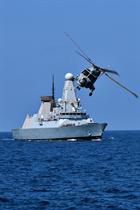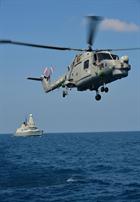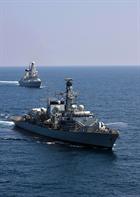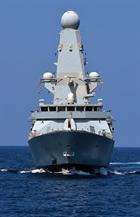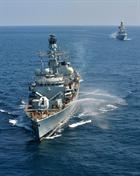Monmouth and Diamond swap places in the Gulf
Britain’s newest operational warship HMS Diamond traded places with HMS Monmouth as the latter relieved the Type 45 destroyer as the Royal Navy’s Gulf guardian.
The two ships have traded places as the Royal Navy’s Gulf guardian; Monmouth has just relieved Diamond, which is homeward bound for Portsmouth after six months in the region on her inaugural deployment. The vessels met up in the warm waters of the Gulf of Aden to conduct a formal handover of duties – and also to engage in good-natured rivalry as the ships’ companies trained fire-hoses on each other during a traditional ‘close sail past’.
Like Diamond (and Daring and many others who have gone before her) Devonport-based Monmouth will be ensuring the safety and security of merchant shipping in a region vital to the UK economy – more than three million barrels of oil pass through the Bab al-Mandab Strait alone each day, making it a vital waterway for supplies of energy to the British economy. HMS Monmouth is prepared to conduct a wide range of duties from boarding operations on suspect vessels, to building relationships with local mariners and monitoring the pattern of life in the area.
“It is just over a year since Monmouth was East of Suez, and after all the training and exercises we have conducted this year we are fully prepared to take over operational duties from Diamond,” said the Black Duke’s executive officer Trish Kohn. “We have a serious job to do over the coming months, however we will of course be thinking of all our families and friends at home, particularly over the Christmas period.”
Which is just when the Diamonds will be back with loved ones again. Beyond her broad ‘policing the seas’ duty, the third of Britain’s six Type 45 destroyers spent a sizeable proportion of her time east of Suez working with US carrier battle groups. Diamond and her sisters were built with the aim of defending a task group from air attack using her Sea Viper missiles, which nestle in a large silo on the forecastle. It was for her air defence role that she was asked to work with not one, or two, but three of the United States Navy’s Carrier Strike Groups operating in the Gulf of Oman and Gulf.
During a three-month period she conducted exercises with them as well as serving as the escort to the aircraft carriers themselves as they used the sea lanes. The carriers – the unique (and now recently-inactivated) USS Enterprise and Nimitz-class carriers USS Dwight D. Eisenhower and USS John C Stennis – are the largest, most powerful surface ships in the world. Each operate with up to 80 aircraft aboard – 50 F18A/B Hornets and F-18E/F Super Hornets as well as E-6B Prowlers and a range of helicopters, airborne early warning and transport aircraft. Diamond’s interaction with CSG 12, led by the Enterprise, held a special significance. While the Type 45 was on her first deployment, it was to be the last for the ‘The Big E’ after almost 50 years of service in the United States Navy. Despite her age, she was still an impressive sight and able to conduct a full range of missions with her embarked air wing of almost 90 aircraft. The work with the three carriers was not confined to manoeuvres at sea. There were also exchanges of personnel and members of Diamond’s ship’s company enjoyed some US hospitality as well as understanding how they conduct their air operations at sea. By appreciating how their carriers, aircraft and escort ships operate together, Diamond’s personnel have been able to apply these various roles to the ones that Type 45 will be required to undertake when HMS Queen Elizabeth and HMS Prince of Wales join the fleet in the next decade.
“Operating with the Carrier Strike Groups was amongst the most professionally satisfying work I have ever had in the Royal Navy,” said Lt Cdr Mark Headley, Diamond’s air warfare officer. “The interaction we have experienced has been of immense value not just for future operations alongside our partner nations but also in preparation for our own carriers coming into service.”
His ship is now making best speed for the Solent in time for Christmas.
Image: LA(Phot) Ben Shread, HMS Monmouth

